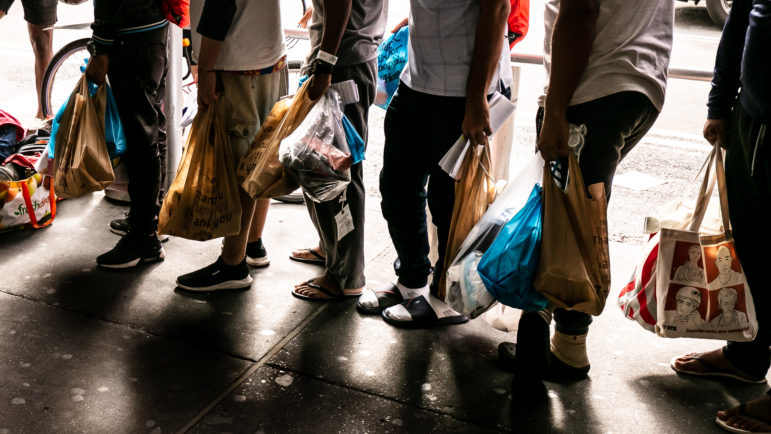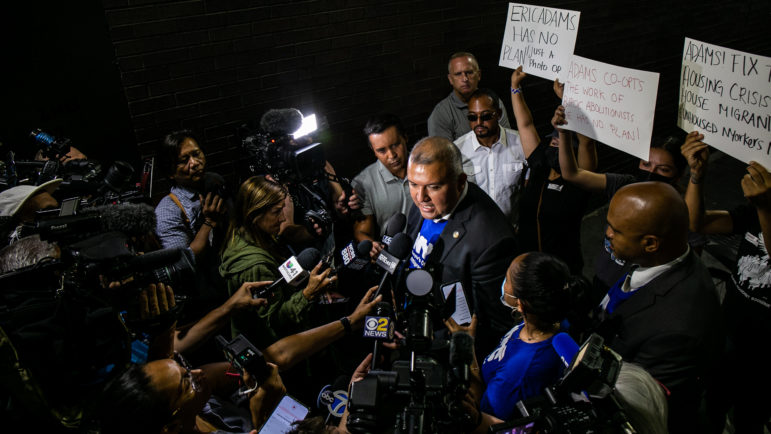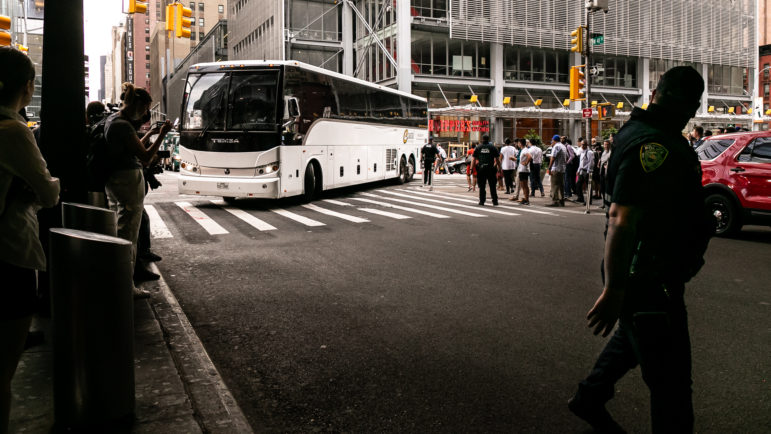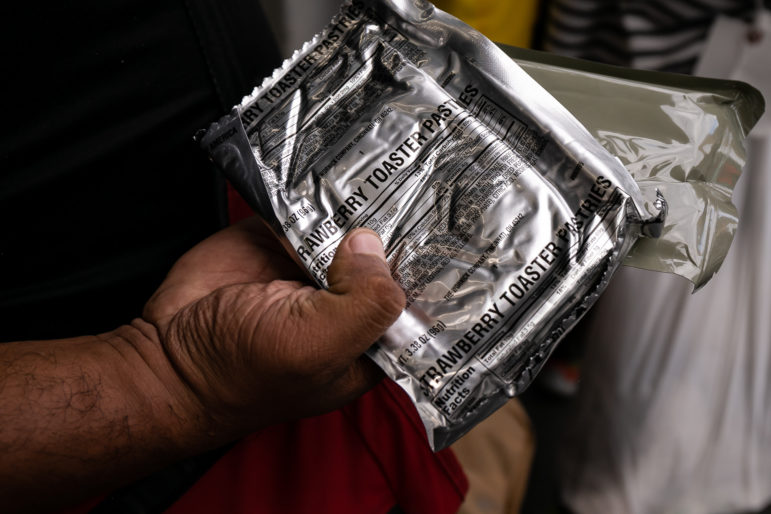The city estimates that around 6,300 asylum seekers have arrived via buses from the border in recent months. In addition to finding a safe place to stay, they must navigate access to medical care, keep tabs on their ongoing immigration cases and in some cases, attempt to reunite with family members they were separated from during their journeys. Some have left the shelter system altogether, citing safety concerns.

Adi Talwar
Immigrants who arrived in New York City on one of the three buses from Texas on Aug. 10, waiting in front of Port Authority on 8th Avenue.Lea la versión en español aquí.
Buses transporting immigrants from the U.S. Southern Border have poured into the Big Apple in recent weeks, part of Texas Gov. Greg Abbott’s political stunt protesting the Biden administration’s border policies.
Within hours, many of the asylum seekers and other recently arrived immigrants entered New York city’s sprawling homeless shelter system, where weeks later they say they are struggling to navigate their new city with little support. On Tuesday, city officials said 6,300 immigrants have entered shelters or visited intake facilities, though that estimate may be higher than the actual number.
Mayor Eric Adams has boasted of the city’s response to the influx of new immigrants. “We have a continuous display of humanitarian assistance as asylum seekers arrived here, and I’m really proud of the response of all of our multi-agency’ interactions,” he said to WCBS 880.
But he’s spoken little about the problems asylum seekers face once they are here. In addition to finding a safe place to stay, they must navigate access to medical care, keep tabs on their ongoing immigration cases and in some cases, attempt to reunite with family members they were separated from during their journeys.
Some who have spoken with City Limits over the past month have described particularly troubling experiences. One man said he was sexually harassed at a shelter. Others have described more run of the mill problems and a feeling that their needs are being ignored.
Jose Rodriguez, who is staying at Brooklyn’s Bedford-Atlantic shelter after arriving from Venezuela earlier this month, said he had received little help from staff, but did manage to connect with an aid group. They provided him with some baggy clothing and a cell phone without a chip. “I need to find a job,” he said in Spanish. “My family is in Colombia and waiting for help.”
Families and individuals have frequently reported that their shelters have few or no Spanish-speaking staff members. “It’s so complicated,” said a woman from Colombia named Katherin Mozo who arrived in New York City with her daughter and husband in early August and made her way to the family intake shelter. “And it’s all in English.”
She said her husband is sleeping in the corner of a cousin’s tiny basement apartment while she and her daughter stay in a Manhattan hotel converted into a temporary shelter. The husband quickly landed a job as a painter. She plans to look for work when her daughter starts school. After that, she said, they will rent an apartment. “We’ll go to New Jersey,” she said. “It’s cheaper.”
The confusion and conditions are motivating some newly arrived immigrants to leave shelters for other options, said Sonia Velázquez, CEO of the nonprofit Your Network Caring Community Advocate. Velázquez said that 14 recently arrived immigrants opted to leave the shelter they were placed at because they did not feel safe.
“They are calling us to inform us about anything that happens,” Velázquez said by phone. The complaints they’ve received include incidents of sexual harassment, fights and theft, as well as a lack of interpreters, prompting some asylum seekers to hit the streets to feel safe in small groups, rather than remain at a shelter.
The head of the New York City branch of Catholic Charities, Monsignor Kevin Sullivan, told city councilmembers that his organization had assisted 1,100 newly arrived immigrants by early August, predominantly young men from Venezuela. Some, he said “are sleeping in the parks.”
The city has been rushing to open shelter facilities inside hotels to keep up with demand in recent weeks, and the Adams administration has promised to soon open an intake facility and resource center specifically for new immigrants. On Friday, the mayor announced the multi-agency plan Project Open Arms which establishes guidelines on the enrollment process, transportation of newly arrived students, language access, social-emotional support and service offerings provided by community-based organizations.
According to the city, at least 1,000 children will enter the city’s school system in the upcoming school year and most asylum-seeking families are concentrated in School Districts 2, 3, 10, 14, 24, and 30.

Adi Talwar
First person disembarking the first of three buses that arrived from Texas at Port Authority in Midtown Manhattan on Aug. 10, 2022.
A frenzied arrival
When 92 immigrants got off three buses at the Port Authority on Aug. 10, volunteers and the mayor’s office staff applauded from the intake area inside the terminal. A nonprofit group provided boxed meals of white rice with black beans and shredded chicken. The newly arrived immigrants also received some clothes and toiletries, most of the items provided by mutual aid groups and other volunteers.
Then came on-site health check-ups, which have been supported by the New York City Fire Department, NYC Care—the city’s health care access program—and nonprofit SOMOS, Inc. “None of them were sick,” NYC Care Executive Director Jonathan Jiménez Pérez told City Limits while leaving Port of Authority that morning.
But that has not been the case with everyone. On the first publicly announced bus that arrived on Aug. 5, a girl in need of insulin was rushed to the hospital, according to Catherine Cole, the executive director of the organization Grannies Respond, one of the main mutual aid groups helping new arrivals. Among the 59 people who came in two buses on Aug. 12, nine went straight to the hospital, according to Shaina Coronel, spokesperson for the Mayor’s Office of Immigrant Affairs (MOIA).
The reception hasn’t all been kind, either. On Aug. 10, passersby approached the media scrum a few steps away from the Port Authority to see what was going on. As immigrants waited to be picked up from the bus depot, a couple of bystanders began recording them, zooming in on their faces, saying “these are the illegal immigrants”—even though crossing the border for asylum isn’t illegal, as asylum seekers are in the process or waiting to receive a government decision on their claim.
“They’re helping them [asylum seekers], but not you,” one of the people filming the migrants quipped to other bystanders, City Limits reporters observed.

NYC Mayor’s Office of Immigrant Affairs Commissioner Manuel Castro addressing the press at Port Authority in Midtown Manhattan. 
The first of three buses from the Texas border arriving at Port Authority in Midtown Manhattan on Aug. 10. 
An immigrant who arrived in New York City on one of the three buses from Texas in August told City Limits that he and others on the bus received eight packets of food each for the two-day bus ride.
Feeling unsafe in shelter
Another man named Jose, who spoke to a reporter in Spanish and asked not to disclose his last name, arrived in New York City on the first bus commissioned by Texas Gov. Greg Abbot on Aug. 5 after traveling from Venezuela and crossing the southern border.
During his first night at a shelter in Brooklyn, Jose, 26, says he went to the shower and was attacked by another shelter resident who pulled open the shower curtain, grabbed him tightly by the wrists, and tried to subdue him. The two wrestled, and Jose said he was able to kick the aggressor’s testicles and escape. He ran to his bed to cry, he said.
Jose said he experienced similar incidents with the same aggressor and other shelter clients over subsequent days at the facility. “The second day, I talked to the psychologist, through the translator,” Jose explained. “She told me to be calm. But it happened again.”
He was relocated to another Brooklyn shelter, but said he did not feel safe there either, and preferred to hit the streets—reflecting a not uncommon sentiment among a portion of the city’s homeless population who would rather bed down in public spaces than stay in shelter, particularly in the city’s large congregate facilities.
“Unfortunately I have nowhere to go,” Jose said. “I come from childhood trauma, and this just happened to reactivate it. To live in a world of anxiety is to return to the past.”
After searching for hours, Velazquez found a church where Jose was allowed to spend the night after he left his second shelter placement. South Bronx Mutual Aid organizer Ariadna Phillips, who has been volunteering to help new arrivals, said she too has had to find alternative sites, like churches, for several of the migrants they’ve been working with who similarly did not feel safe in shelter.
“Protecting the health and safety of our clients is our top priority at all times,” a New York City Department of Social Services spokesperson said via email. “Together with the not-for-profit provider-partners that manage our sites, our dedicated staff work closely with clients to ensure that we are maintaining open lines of communication and any concerns are addressed.”
“More importantly, we do not tolerate any misconduct against or amongst clients, and have processes in place to ensure that such cases are immediately investigated and addressed,” the spokesperson added.
DSS explained that they have channels for clients to safely report any misconduct, along with due processes for prompt investigation and redressal. Jose said he made verbal complaints in the shelter where the harassment incidents occurred, and on one occasion had a remote medical checkup.
But DSS did not respond to other inquiries by City Limits, including how many asylum seekers have reported sexual harassment or violence in shelters in recent months. The agency instead pointed to reforms it has made to enhance and strengthen reporting mechanisms for serious incidents in shelter, including a new unit within DSS and Department of Homeless Services to oversee the notification and response process.
A half a country away
City Limits spoke with one man who says he was separated from his family as a result of his border crossing. He preferred not to be publicly identified for fear of retaliation, but is from Venezuela and crossed the border in early August. Once he and his wife crossed, U.S. Customs and Border Protection (CBP) separated them, he said.
“As soon as we were apprehended, they put her in the women’s line, along with her friend [with whom they traveled from Venezuela] and me in the men’s line,” he said over the phone.
“I explained to them that we were married but they still kept us apart,” he said, saying their marriage certificate had been lost during their journey north, carried away by the strong current in one of the Darien Gap rivers.
The husband and wife were processed by immigration officials in different places, and the man was held for two days, while his wife and friend were held longer, according to the man’s account. After CBP released him, he was transferred to San Antonio. While there he was offered a bus ride to New York.
“I spoke to an agent to tell him that my wife was in Texas, and he said she would be sent to New York as well,” the man, in his 40s, said. “But she was not sent.”
At least three men who arrived alone on Aug. 10 buses to the Port Authority similarly had family in Texas and yet were brought to New York, advocates and bussed migrants told City Limits. “Families are getting separated,” said an organizer for Black LGBTQIA+ Migrant Project (BLMP), which works with asylum seekers in Texas.
Gov. Greg Abbott’s office did not respond to this accusation and other questions posed by City Limits, but told the New York Post that migrants have signed waivers acknowledging that the program is voluntary. But the Mayor’s Office of Immigrant Affairs Commissioner Manuel Castro, and mutual aid organizations in both Texas and New York, have questioned that assertion, arguing that some have boarded buses against their will.
Roland Martinez, public relations manager for the city of San Antonio, says that between July 7 and Aug. 8, 1,561 of the migrants that arrived at the city’s Migrant Resource Center listed the state of New York as their final destination, with 880 of those designating New York City specifically.
“If they are going to New York it is because it is listed on their paperwork from Border Patrol and they have family or other resources there,” Martinez said.
The man who is here without his wife said the couple learned about New York as a destination option through a Facebook page. The city has a unique right-to-shelter provision, meaning it is legally mandated to provide temporary shelter to anyone experiencing homelessness who visits an intake site.
The man said his wife was released from CBP custody on Aug. 8, when the bus her husband had boarded was halfway to New York. In a San Antonio shelter, staff told her that they could not send her to New York because its shelters were full, the man said.
When he spoke to City Limits, he was searching for organizations that could help him pay for his wife’s ticket to the city.
“I can’t figure out what to do,” he said.
Additional reporting by David Brand








